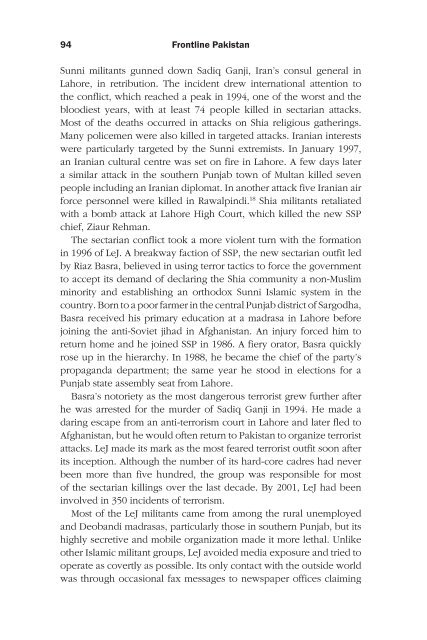Frontline Pakistan : The Struggle With Militant Islam - Arz-e-Pak
Frontline Pakistan : The Struggle With Militant Islam - Arz-e-Pak
Frontline Pakistan : The Struggle With Militant Islam - Arz-e-Pak
Create successful ePaper yourself
Turn your PDF publications into a flip-book with our unique Google optimized e-Paper software.
<strong>Frontline</strong> <strong><strong>Pak</strong>istan</strong><br />
Sunni militants gunned down Sadiq Ganji, Iran’s consul general in<br />
Lahore, in retribution. <strong>The</strong> incident drew international attention to<br />
the conflict, which reached a peak in 1994, one of the worst and the<br />
bloodiest years, with at least 74 people killed in sectarian attacks.<br />
Most of the deaths occurred in attacks on Shia religious gatherings.<br />
Many policemen were also killed in targeted attacks. Iranian interests<br />
were particularly targeted by the Sunni extremists. In January 1997,<br />
an Iranian cultural centre was set on fire in Lahore. A few days later<br />
a similar attack in the southern Punjab town of Multan killed seven<br />
people including an Iranian diplomat. In another attack five Iranian air<br />
force personnel were killed in Rawalpindi. 18 Shia militants retaliated<br />
with a bomb attack at Lahore High Court, which killed the new SSP<br />
chief, Ziaur Rehman.<br />
<strong>The</strong> sectarian conflict took a more violent turn with the formation<br />
in 1996 of LeJ. A breakway faction of SSP, the new sectarian outfit led<br />
by Riaz Basra, believed in using terror tactics to force the government<br />
to accept its demand of declaring the Shia community a non-Muslim<br />
minority and establishing an orthodox Sunni <strong>Islam</strong>ic system in the<br />
country. Born to a poor farmer in the central Punjab district of Sargodha,<br />
Basra received his primary education at a madrasa in Lahore before<br />
joining the anti-Soviet jihad in Afghanistan. An injury forced him to<br />
return home and he joined SSP in 1986. A fiery orator, Basra quickly<br />
rose up in the hierarchy. In 1988, he became the chief of the party’s<br />
propaganda department; the same year he stood in elections for a<br />
Punjab state assembly seat from Lahore.<br />
Basra’s notoriety as the most dangerous terrorist grew further after<br />
he was arrested for the murder of Sadiq Ganji in 1994. He made a<br />
daring escape from an anti-terrorism court in Lahore and later fled to<br />
Afghanistan, but he would often return to <strong><strong>Pak</strong>istan</strong> to organize terrorist<br />
attacks. LeJ made its mark as the most feared terrorist outfit soon after<br />
its inception. Although the number of its hard-core cadres had never<br />
been more than five hundred, the group was responsible for most<br />
of the sectarian killings over the last decade. By 2001, LeJ had been<br />
involved in 350 incidents of terrorism.<br />
Most of the LeJ militants came from among the rural unemployed<br />
and Deobandi madrasas, particularly those in southern Punjab, but its<br />
highly secretive and mobile organization made it more lethal. Unlike<br />
other <strong>Islam</strong>ic militant groups, LeJ avoided media exposure and tried to<br />
operate as covertly as possible. Its only contact with the outside world<br />
was through occasional fax messages to newspaper offices claiming













